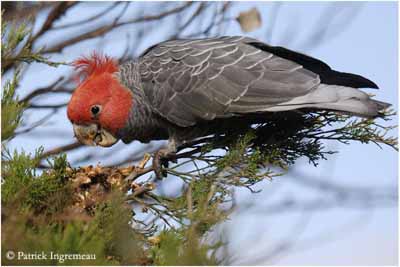
Gang-gang Cockatoo
Callocephalon fimbriatum
Psittaciforme Order – Cacatuidae Family
BIOMETRICS:
Length : 32-37 cm
Weight : 280-330 g
DESCRIPTION:
Gang-gang Cockatoo is unmistakable. It is the only one with conspicuous curled crest of fine feathers.
Adult male has grey body plumage. On the upperparts, feathers are white-edged whereas on the underparts, they are yellowish-edged.
Flight feathers and rectrices are darker grey. Secondary coverts are tinged dull green.
The head is bright red and shows a forwards-curving crest on the rear crown, made with very fine feathers named “filaments”. The nape is grey.
The hooked bill is horn-coloured. Eyes are dark brown, surrounded by greyish eye-ring. Legs and feet are dark grey.
Fr: Cacatoès à tête rouge
All : Helmkakadu
Esp: Cacatúa Gang-gang
Ital: Cacatua gang-gang
Nd: Helmkaketoe
Russe: Шлемоносный какаду
Photographs by Patrick Ingremeau
TAMANDUA
Text and pictures of captive birds by Nicole Bouglouan
Sources:
HANDBOOK OF THE BIRDS OF THE WORLD vol 4 by Josep del Hoyo-Andrew Elliott-Jordi Sargatal - Lynx Edicions - ISBN: 8487334229
PARROTS OF THE WORLD – An Identification Guide – by Joseph M. Forshaw – Princeton University Press – ISBN 0691092516
Birds in backyards (Birds Australia and Australian Museum)
Wikipedia (Wikipedia, The Free Encyclopedia)


Female is quite different with grey plumage overall, including head and crest. However, the upperparts are heavily barred yellowish, and underparts are barred orange to pale yellowish-green. Undertail feathers are barred whitish.
Crest and head are darker grey.
Juvenile is very similar to female, with shorter crest, slightly red-tipped in young males.
VOICE: SOUNDS BY XENO-CANTO
Gang-gang Cockatoo utters long rasping screeches almost similar to a rusty hinge or a cork twisting from a bottle! This call is given in flight or when the bird is perched at treetop.
When feeding, this cockatoo utters soft growling.
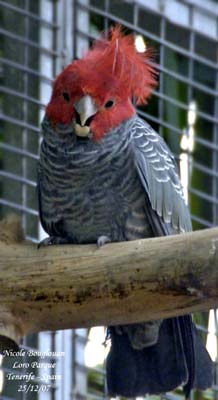
HABITAT:
Gang-gang Cockatoo may be seen up to 2000 metres of elevation, and frequents mountain forests with dense understorey in summer.
In winter, it performs altitudinal movements to more open woodlands, forests and wooded coastal plains.
This species also frequents the urban areas in winter.
RANGE:
Gang-gang Cockatoo is found in south-eastern Australia and it is endemic to this region.
The species has been introduced to Kangaroo Islands (S Australia).
BEHAVIOUR:
Gang-gang Cockatoo feeds mainly on eucalypt and acacia seeds and fruits. In winter, they are attracted to urban areas where they can find their preferred food trees.
They are often seen in small groups outside breeding season, and we can see large flocks at food and water sources.
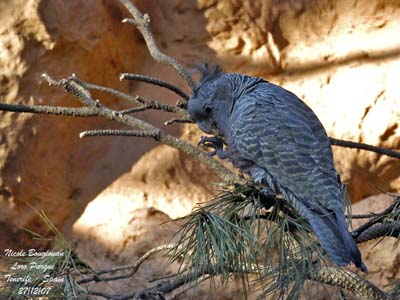
Gang-gang Cockatoo is an arboreal species and comes to the ground only for drinking or taking seeds from fallen cones. This species is very tame when feeding.
During the breeding season, they are seen in pairs or family groups.
They rest in the leafy trees during the warm hours of the day, but they may perform aerobatics during rain and snow showers.
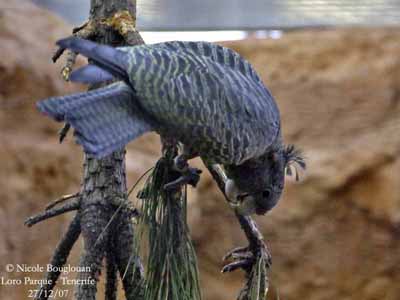
FLIGHT:
Gang-gang Cockatoo is a powerful flier, but it usually performs short flights between trees. Its flight is “owl-like” with slow wing beats.
During the aerobatics, they circle above the canopy, sometimes swooping down through the trees.
The long-distance flights occur at great height, ending in spiral towards the ground, accompanied by twisting and turning sequences.

REPRODUCTION:
Gang-gang Cockatoo breeds from October to January.
They breed in the high mountain forests. The nest is a hollow where the female usually lays two white eggs. Incubation by both parents lasts about 24 to 30 days in captivity.
The chicks are fed by the adults during 7-8 weeks. When the young fledge, they are still fed for 4 to 5 weeks more.
They remain in family groups all the winter.
DIET:
Gang-gang Cockatoo feeds in the canopy of trees and shrubs, eating fruits and seeds in Eucalyptus forests. It holds the fruit in one foot and opens it with the bill. The seed is extracted with the lower mandible and the tongue before to be swallowed.
They eat numerous exotic fruits in urban parks and gardens. They also eat insects and their larvae.
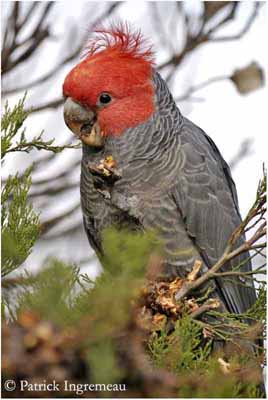
PROTECTION / THREATS / STATUS:
Gang-gang Cockatoo is usually common in its range, thanks to the wintering in Canberra suburbs.
This species is also protected from human robbers by nesting in high forests where it is difficult to find the birds and their nests.